Can you say "Szlak Orlich Gniazd"?
⬅ previous ⬆intro next ➡Day 2 ~ 29 June ~ Kraków
It's Saturday. We are going to do a real international parkrun, after finding that the Isle of Man still comes under the "British" umbrella in parkrun terms despite not being part of the UK.
There are three parkruns considered local, although the one most in demand for alphabet-collectors, "Zielony Jar", is also the furthest away. We're going for the closest because we're not really sure how transport works here. According to Google, we can take a tram from a short walk away right to the start, and it sounds easy enough to buy tickets, but we think we won't take too many chances first time.
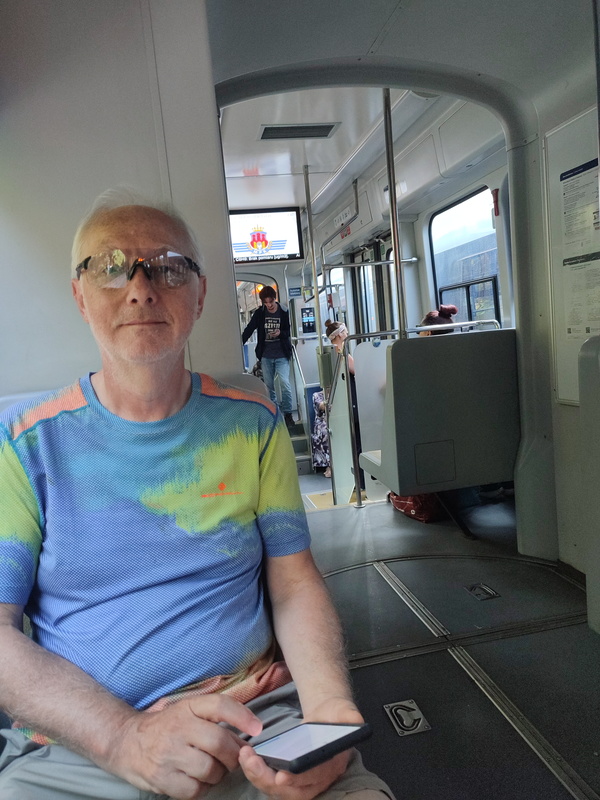
And indeed the tram is all very straightforward. There are two services that would do us, and by sheer luck, we've got the one that actually terminates at our destination, so that's easy.
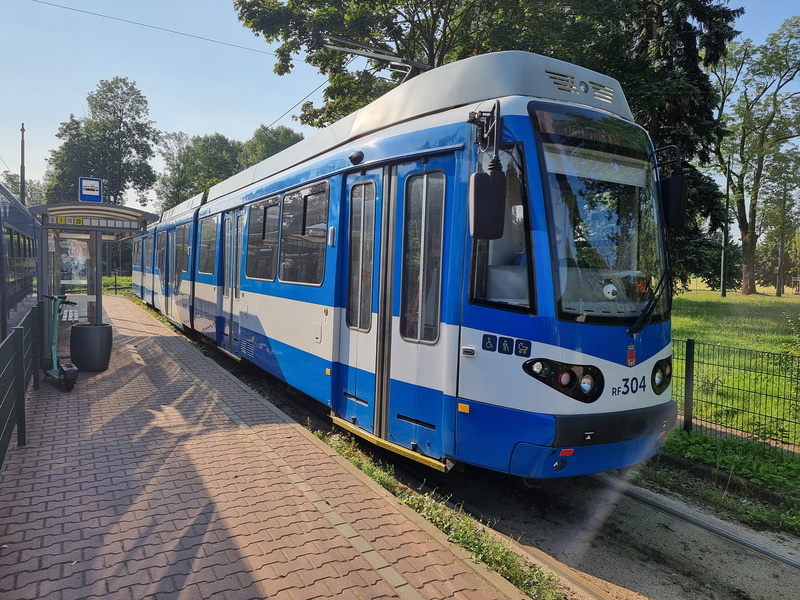
And here is the end of the line. The trees on the right are pretty much where the parkrun starts.
We find we've given ourselves far more time than needed, so we have a bit of a stroll around half the route or so first. It's basically around a large open space, so there's very little shade and we are expecting it to be quite hot. It's a lot warmer here than when we left, and we gather that the British weather is getting cooler still.
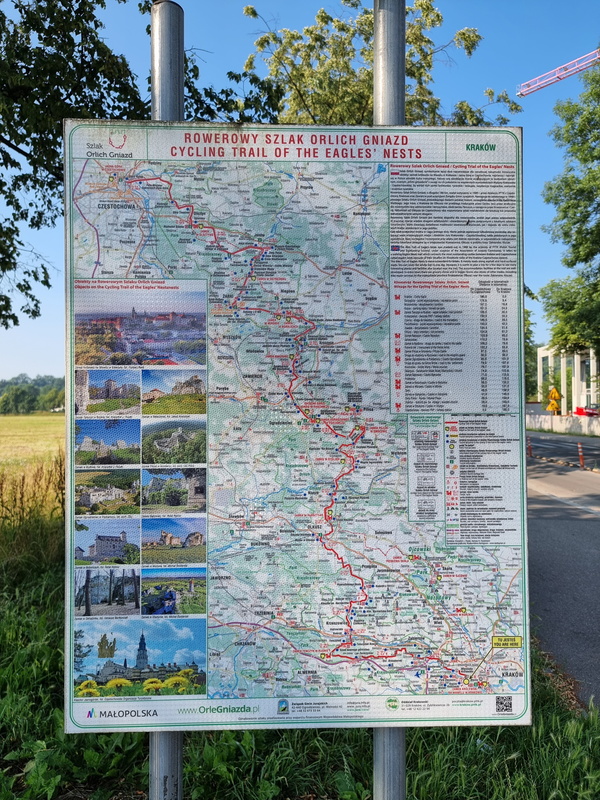
That's interesting. It's a sign describing our planned cycle ride, although from the assumption of starting here and heading out, while we'll be doing it in the opposite direction.
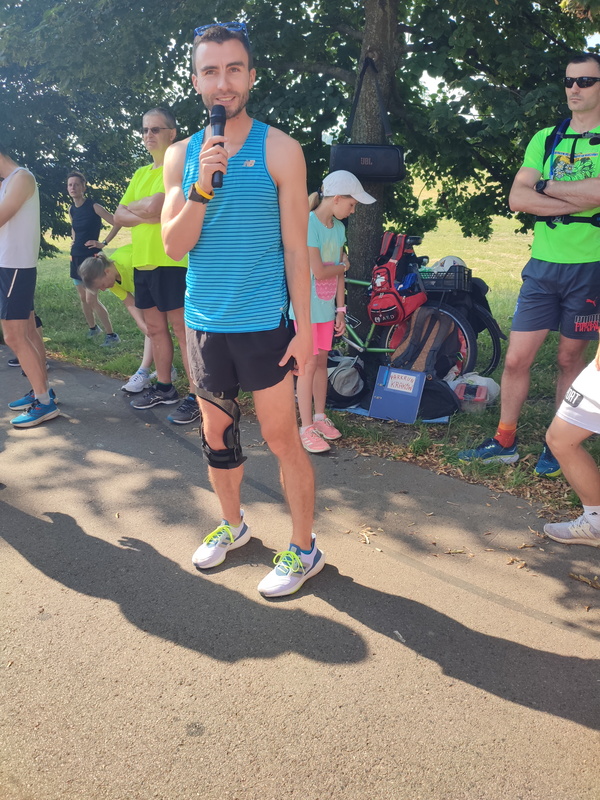
The RD alternates between Polish and English: we are among quite a large contingent of Brits.
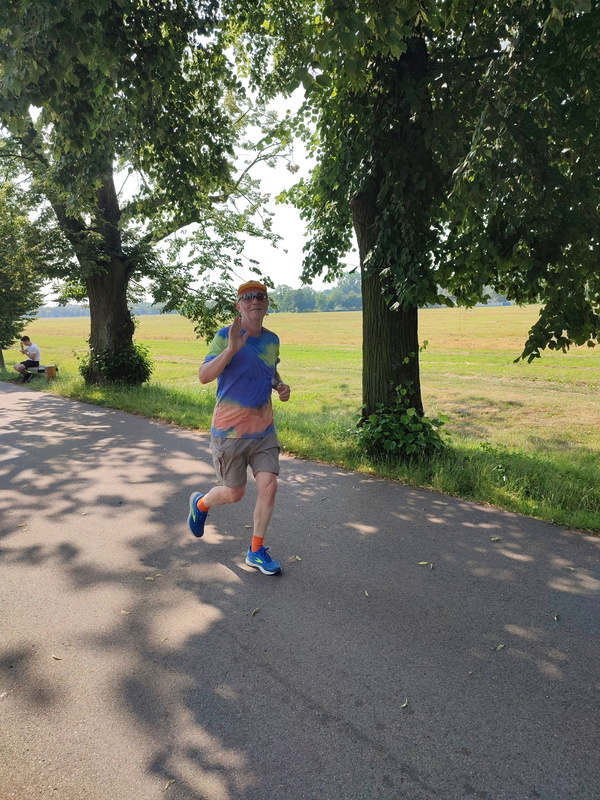
In different conditions, this would be a very fast course: apart from one hairpin near the start there are no sharp curves, it's all on paths and virtually flat. In this heat and humidity it's not! Amanda is slightly concerned that I'm taking longer than she expected, but no, I'm fine. Everyone is far slower than normal it would seem.
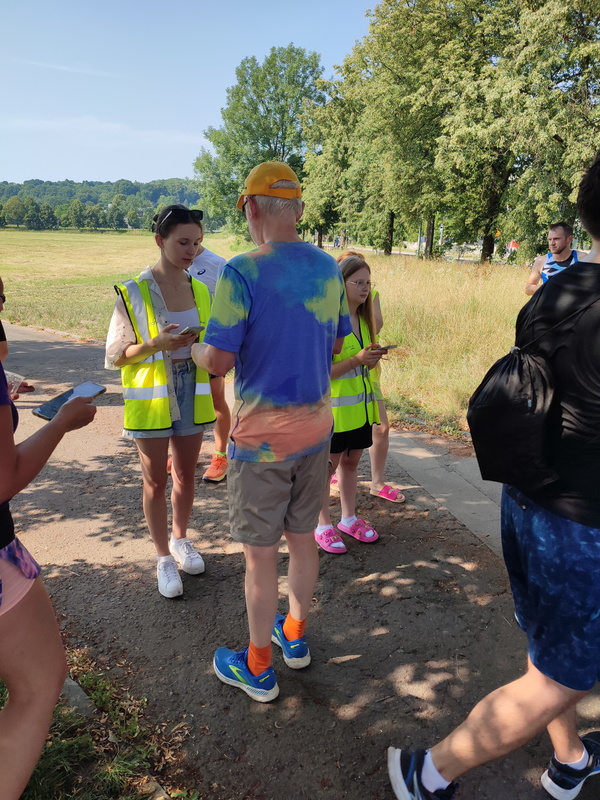
Bushy-park-busy it's not!

One of the other Brits we've got talking to takes this picture for us.
They'd been a lot less bold and brave than us, and got an Uber instead of the tram. Google reckoned that the traffic was such that it would have been no quicker to go by cab, and certainly a lot more expensive, but we're not smug.
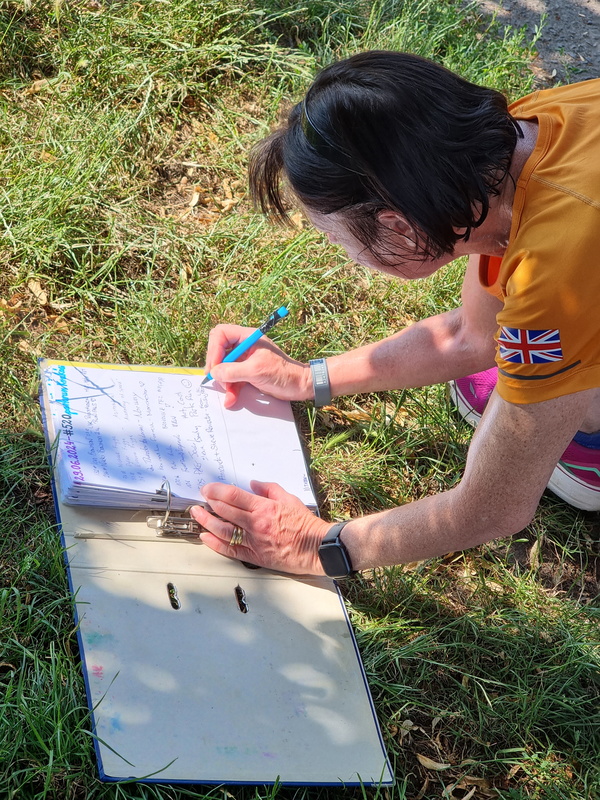
And Amanda signs the visitors' book.
After this, we get the tram back to the centre, and as it's departing, we notice our earlier acquaintances standing at the side of the road obviously still waiting for their Uber.
We've booked on a city walking tour later this afternoon, so the plan is to go back to the apartment for a quick shower and then meander slowly across town to the rendezvoush point via a lunch stop.
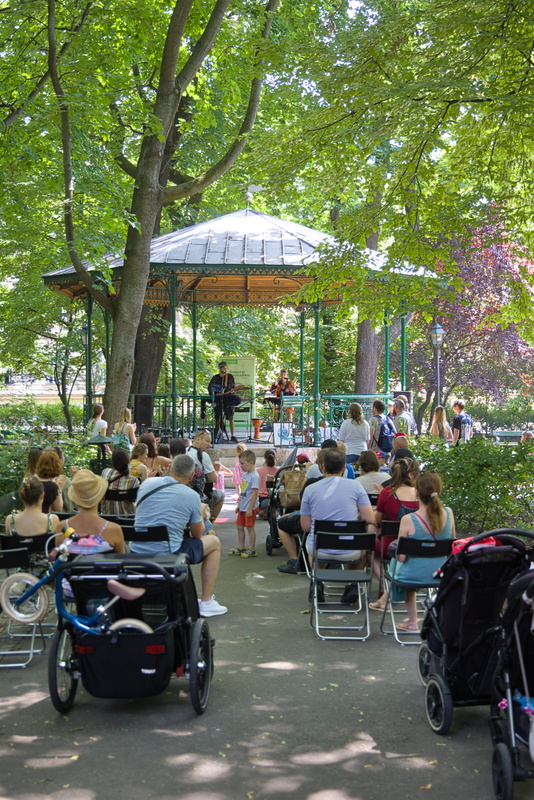
Music in the park.
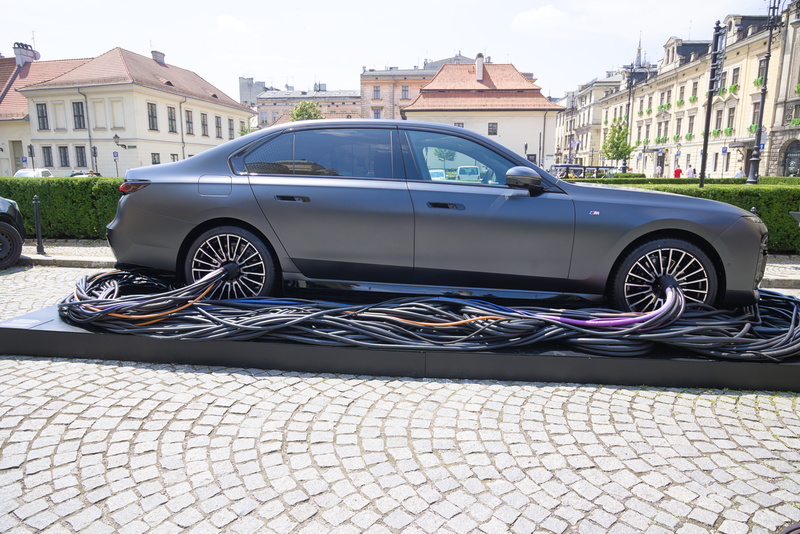
This appears to be some kind of advertisement for an electric car. It's a BMW i7, but we aren't quite sure we understand the wires. They seem a bit impractical. Mind, given that its starting price in the UK is over a hundred grand, maybe the idea is you get a free work of art thrown in. There's a board on the other side with a somewhat weird picture and a QR code that links to Instagram, where we can see it in "Dream of the Machine Augmented Reality". Ok, maybe when we've got nothing better to do...
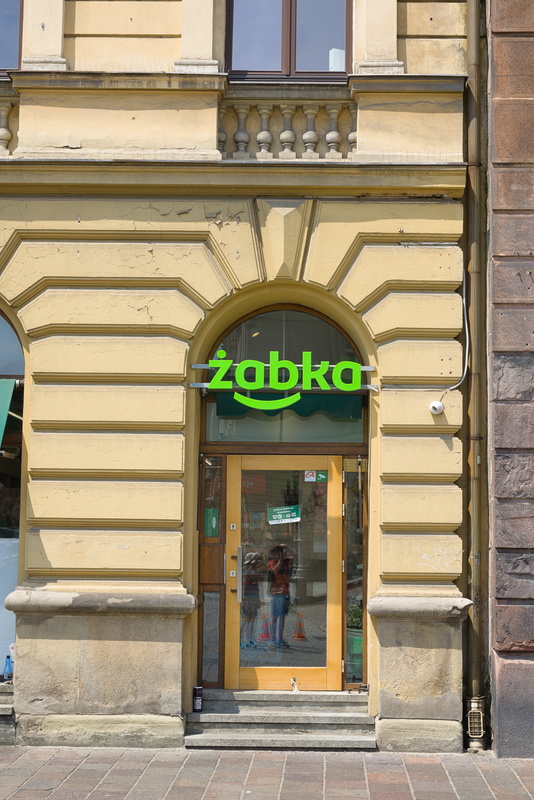
Apropos of nothing, but we ought to mention this chain of small supermarkets scattered throughout the city, where we have been several times to buy provisions.
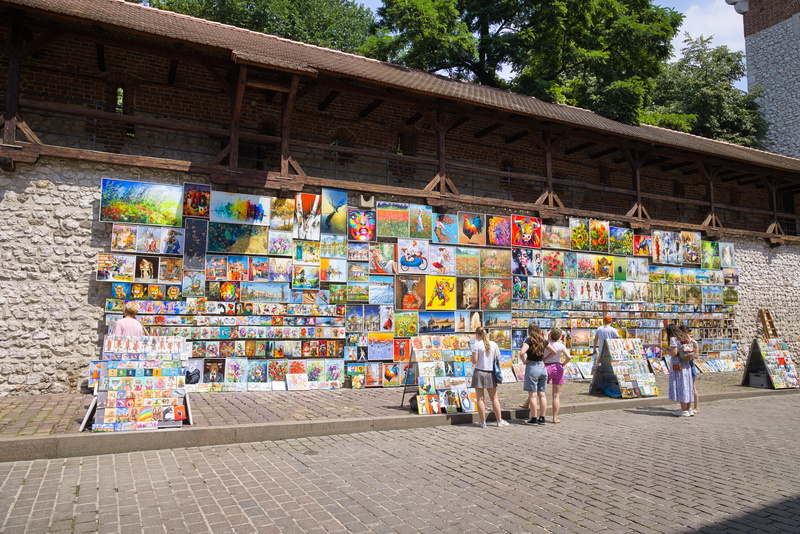
Paintings for sale just inside the (reconstructed) wall of the old town. Nothing quite catches our eye.
It's getting to be lunchtime now, so where shall we go?
We ask the great god Google for some recommendations, but we want somewhere on the square with a nice view and it doesn't seem terribly helpful. One place sounds nice, and looks well situated on the map, but it turns out that the map doesn't reflect reality.
No matter, we'll just take our chances.
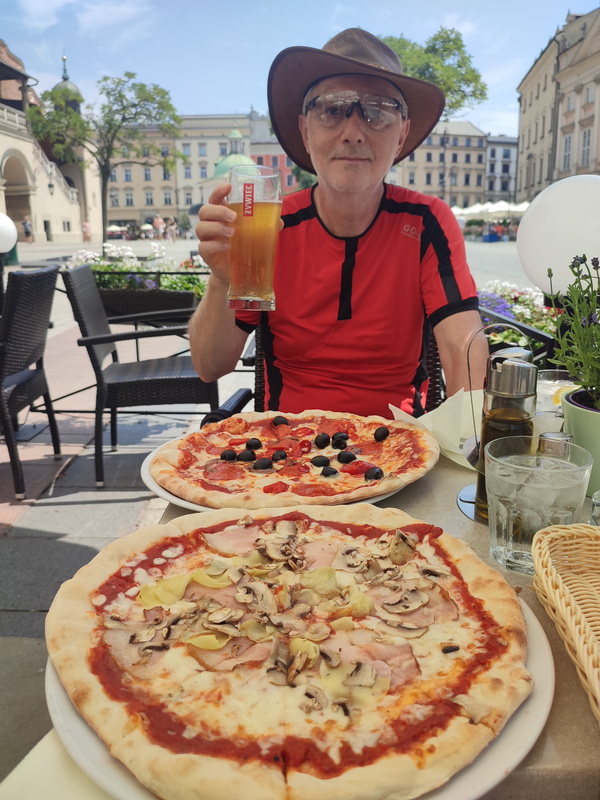
Another fine Polish beer, and some very decent pizza, although we would not have been left feeling hungry if we'd just shared one between us.

We gather the area is known for its amber, and there's an arcade full of little stalls selling amber jewellery and the like.
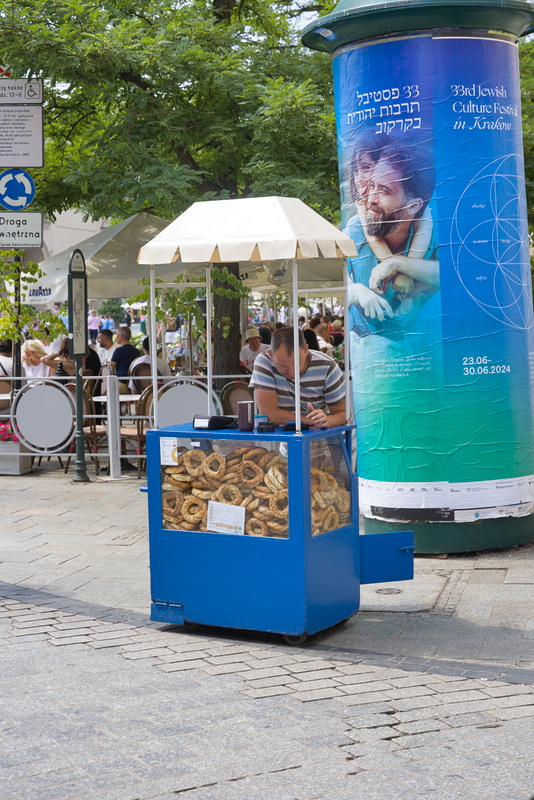
Another local speciality is pretzels, but we only seem to see the stalls when we're not hungry.
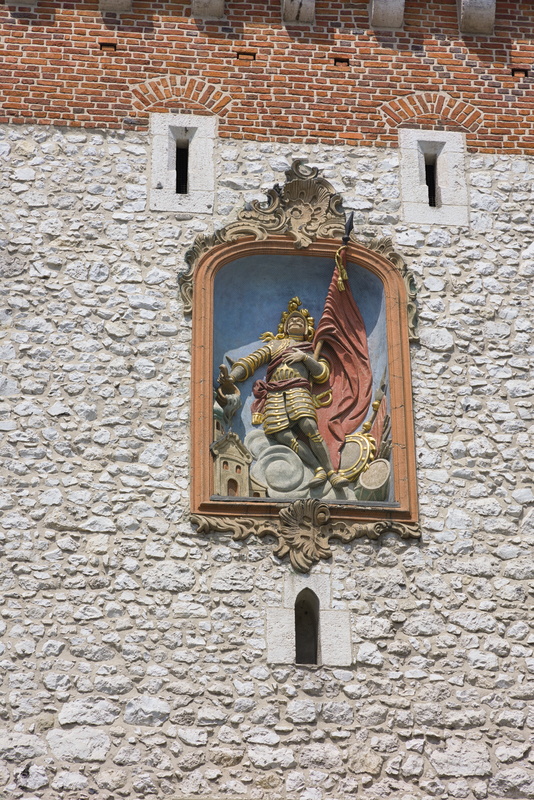
Saint Florian.
He's perched here above the city gate named after him, but it seems he's not just a holy doorman, he's the Patron Saint of all Poland, and Kraków boasts some of his relics, granted them by Pope Lucius III in the year 1184. He's also the patron saint for chimney sweeps and soapmakers, and especially firefighters, since being chief of a Roman military fire brigade in the 3rd century had been his day job. In 303 AD, though, Diocletian and his co-emperors of the Tetrarchy ramped up Christian persecution a fair bit and poor old Florian was martyred.
He has no intrinsic connection to Poland, having been born in what is now Austria. It seems he was adopted for political reasons, although his veneration is quite widespread in Central European nations.

It's time for our tour now, and here is our guide giving us a little introductory speech.
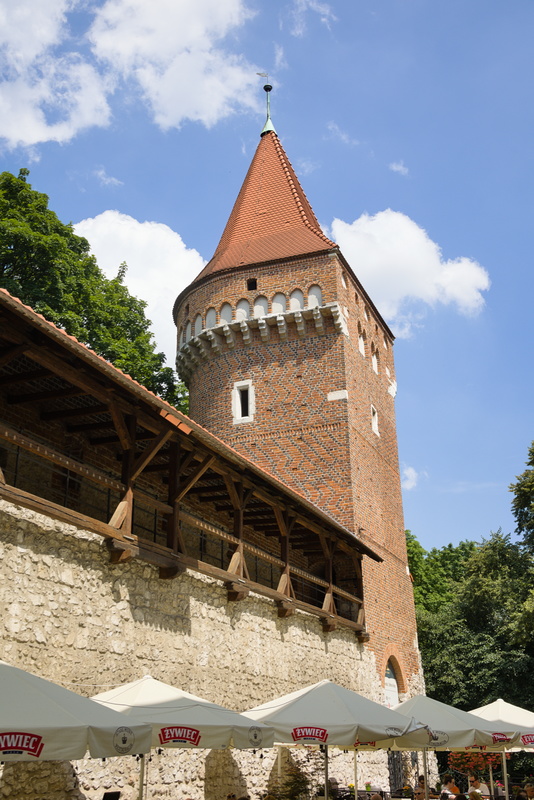
Only a short section of city wall now remains, and it's been very heavily restored so it probably looks quite a lot like it did in its heyday rather then being a straight historical site.
I'm not quite sure why this tower is curved on the outside and flat on the inside, but I'm going to guess it's because the curved wall is stronger, but the flat wall is much cheaper to build, so preferred for the parts that wouldn't face an enemy. Certainly the cost of maintaining the fortifications was more than the city wanted to afford, and the generally decrepit structures were mostly demolished in the 19th century.
So why was this section preserved? The story goes that a local senator, Feliks Radwański, argued that retention was necessary to protect the city from strong winds that would otherwise blow the ladies' skirts up in the streets! As it says on one tourist website, "playing the old 'fear the przeciąg' card, eh? Nice one, Feliks!" To save you googling it, "przeciąg" is Polish for "draught". And in case you want to know how to pronounce this rather consonant-heavy word, the IPA rendering is [ˈpʃɛʨ̑ɔ̃ŋk]. Not helpful, well something like "pSHEHT-choonk"
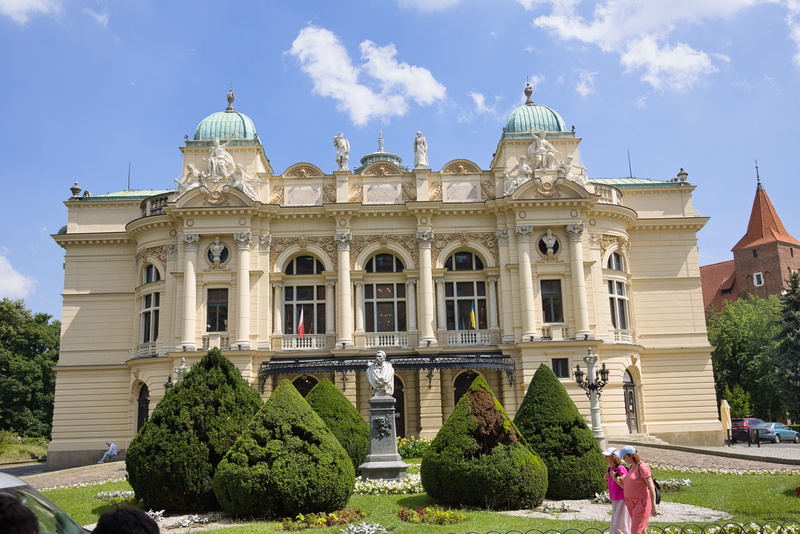
The grand 19th century Juliusz Słowacki Theatre, first building in Kraków to have electric lighting!
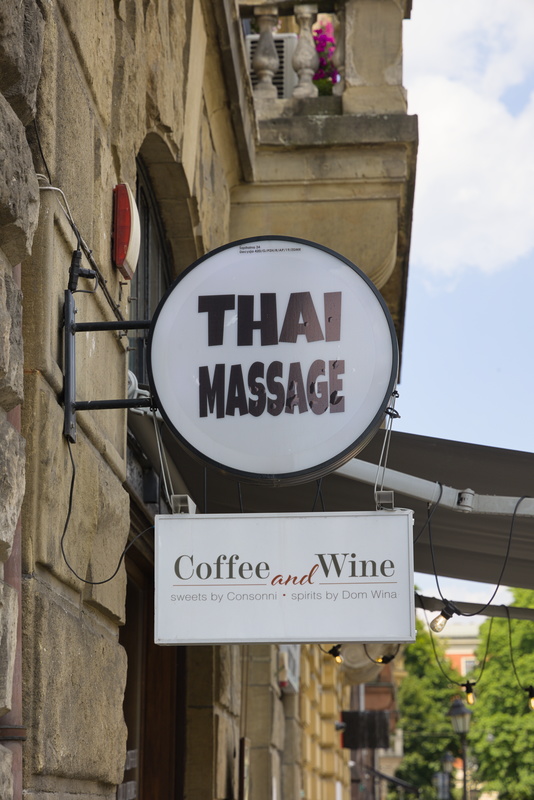
Clearly not an institution that sets arbitrary boundaries. Some enterprising Pole has seen a synergy that others have missed.
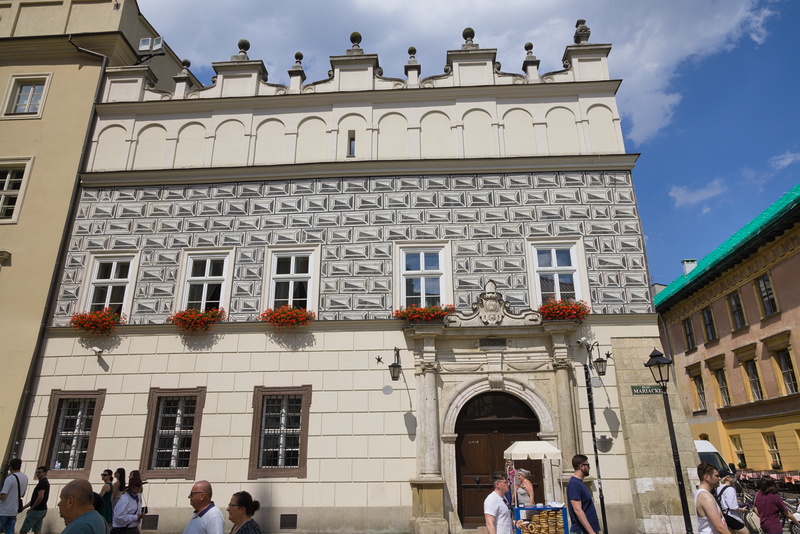
This trompe l'oeil paint effect for the middle 'stone' course can be seen on a number of buildings.

This knife hangs over the entrance to the Drapers' Hall. According to our guide, it was intended to warn would-be thieves that the penalty for getting caught would be to have an ear cut off! That makes it particularly ironic, because it's not the original knife: the original was stolen! (There are other legends to explain its presence, though, so it looks like the truth has been lost in antiquity.)

Into the Jagiellonian University Museum to see their musical clock. Every two hours, a tune plays and a procession of figures emerge and retreat.
The first clock was installed by at least 1465, when repairs are documented to have taken place, but this is the fourth in succession, dating to the year 2000.
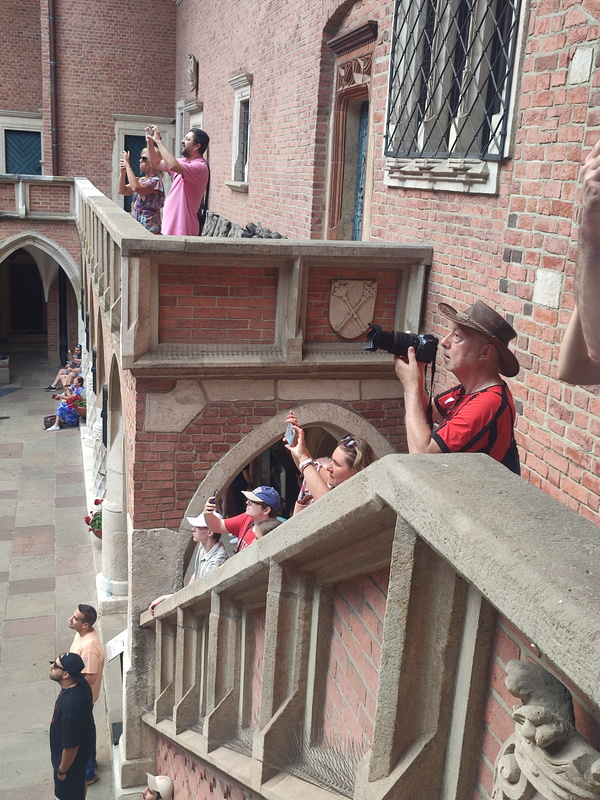
As you can see, it's quite a popular attraction.
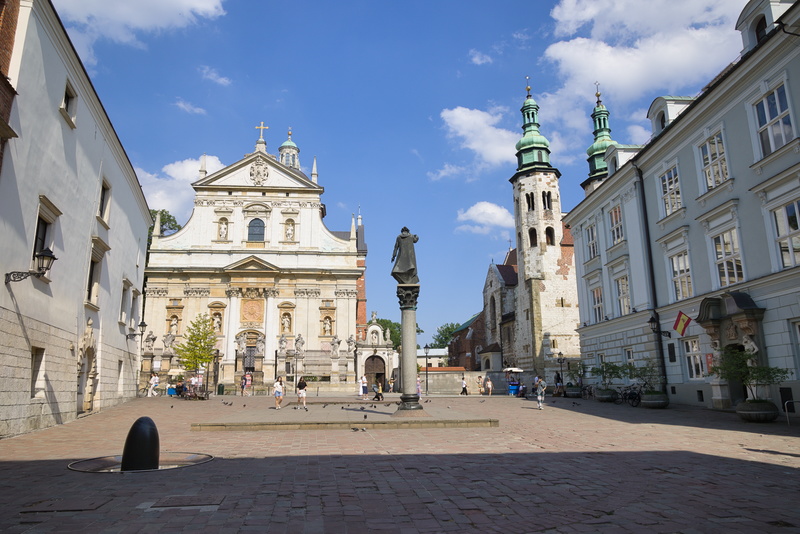
Ahead and to the left is Saints Peter and Paul Church, while partially obscured to the right is Saint Andrew's.
That's St Peter himself on the pedestal.
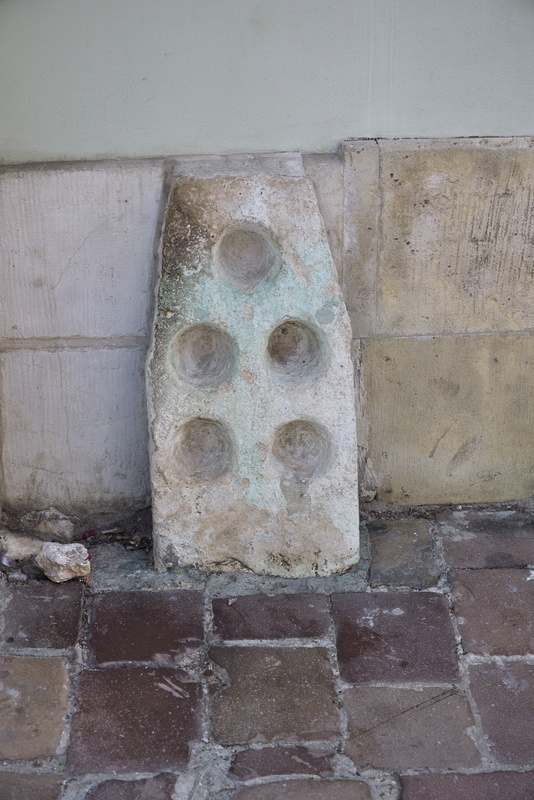
You see these and similar stones with circular holes all over town. We have a few guesses at what they might be, but none of us get it right. (My own suggestion of cannon-ball holders was perhaps not entirely serious). They're for dowsing your torches in the days before street lighting. Flaming torches in those days weren't just for wielding along with your pitchfork when storming the castle, they were a night-time necessity. But why so many? Well, if you were a rich noble out walking, you might be with friends, and certainly with several burly servants to dissuade mediaeval socialists from redistributing your wealth. You'd therefore have quite a few torches between you, and nobody would want to hang about waiting for a free slot in the cold of a Polish winter night.
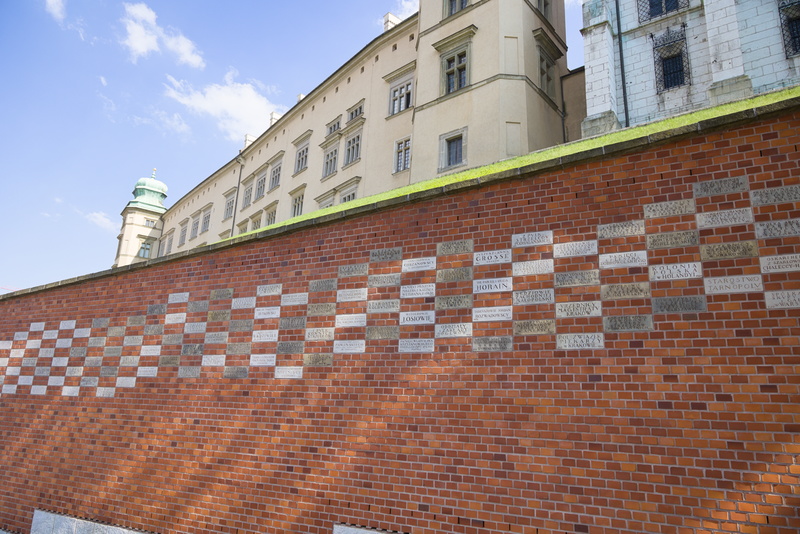
As we walk up to the Wawel castle complex, we pass a wall with bricks commemorating local citizens who contributed to the castle restoration in the 1920s. Read more here, it's actually quite a story.
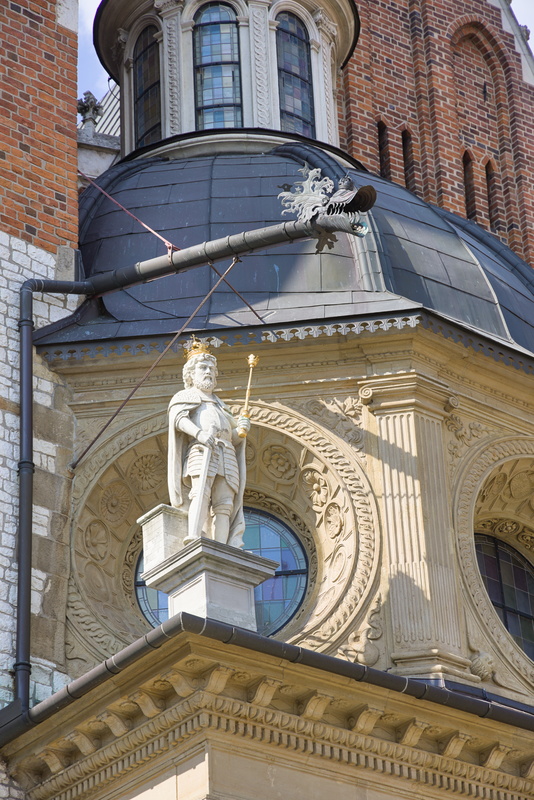
This is curious. It looks like a gargoyle, but gargoyles are part of the rainwater guttering and this appears to be pipework coming up from below. That would probably make it a soil pipe vent, but then why the need for the horizontal section at all? If I zoom in to the original full-resolution image, it's still hard to be certain exactly what's happening at the join, but it's far from impossible that a downpipe that can't be seen leads in from behind. Could be multi-purpose I suppose.
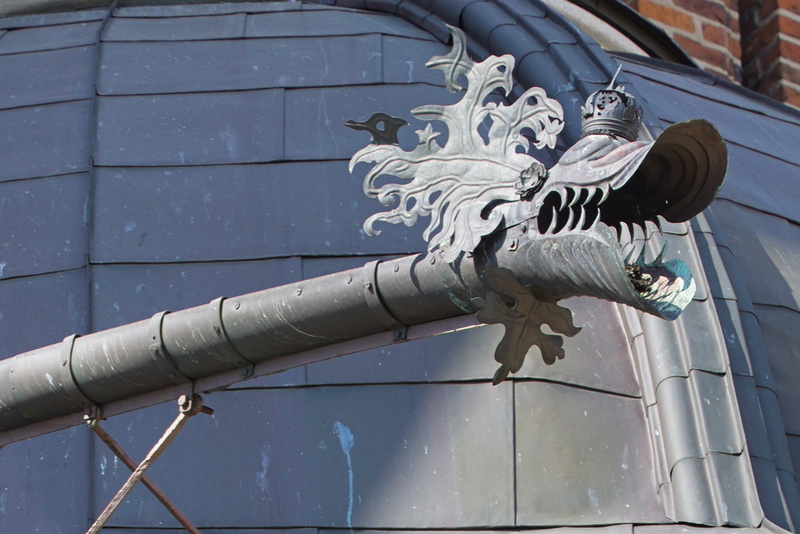
I'm more interested in the dragon head and don't even notice the plumbing conundrum at this point.
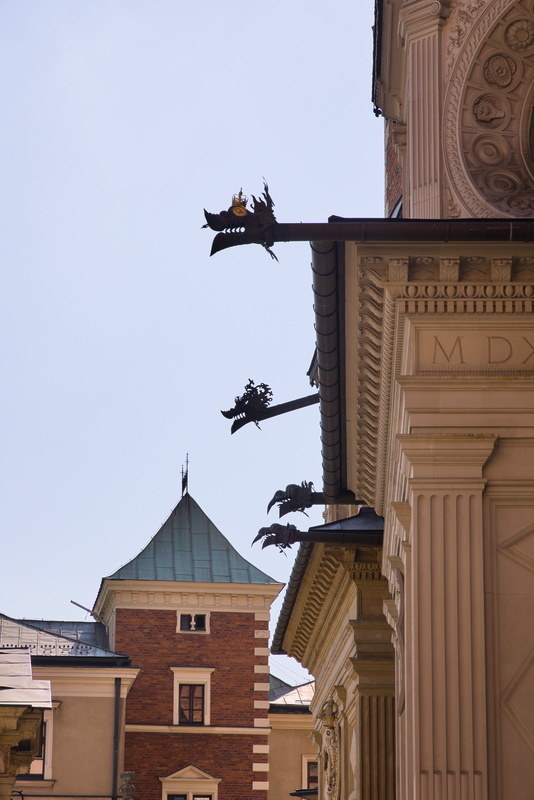
These must be gargoyles, definitely!
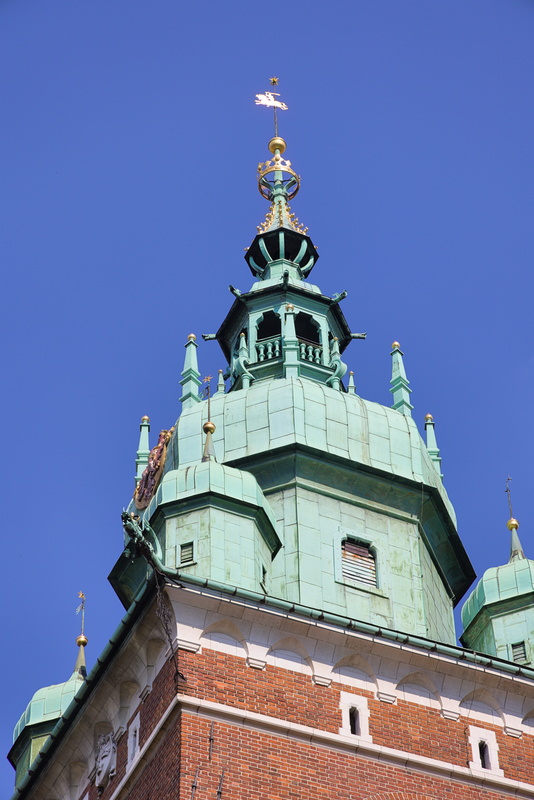
Funny, we're not at all fans of architectural rust, but the same thing except that it's copper, not iron, oxide makes everything completely different.
So, city tour done, we just have to pay what we think it was worth. Based on what we've seen of local prices generally, we reckon 50 Zloty - ten quid - from each of us each is fair, and now we'll stroll back to our apartment.
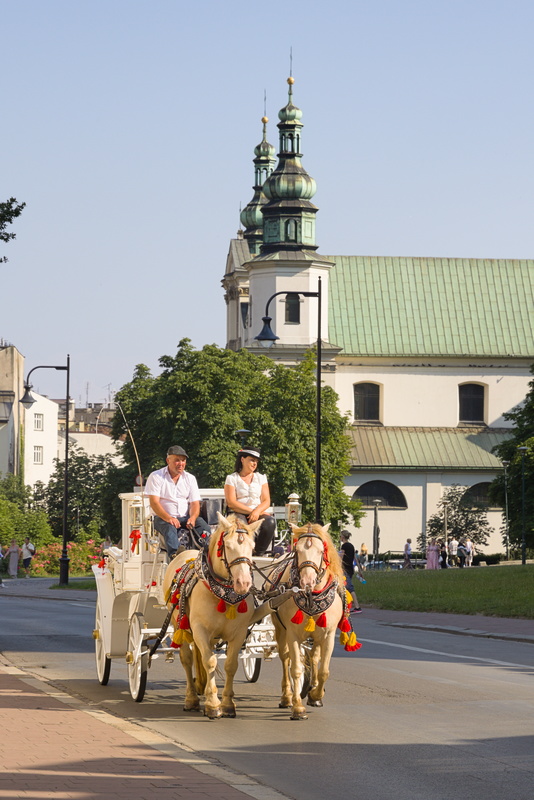
We've not really been tempted ourselves, but there are plenty of horse-drawn carriage tours.
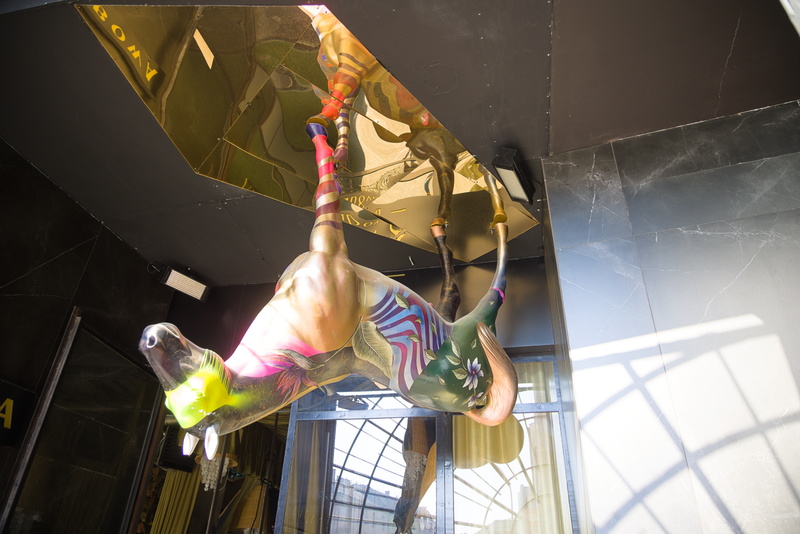
And here we have, as one does, a polychrome inverted equine sculpture.
We are a touch remiss in not making any note of the context here, because it turns out to be surprisingly difficult to find any reference to this online. However, based on piecing together what few scraps I can find, my GPS track and Google Street View, I think this is "Nova Klubova", described on its website as,
NOVA KLUBOVA is a combination of the club, cocktail bar and restaurant in the center of Krakow’s Kazimierz. Inspired by the Parisian Buddha, the place will meet the expectations of the most demanding guests.Well that's it: now I have to find what on earth the Parisian Buddha is! Ah right, Wikipedia knows. "The Buddha-Bar is a bar, restaurant, and hotel franchise created by French-Romanian restaurateur Raymond Vișan, with its original location having opened in Paris, France in 1996."
Never heard of it before but now I know. Not having been there, nor going to this place here, I am doubly unqualified to comment on the accuracy of the homage.
Back, then, to our apartment.
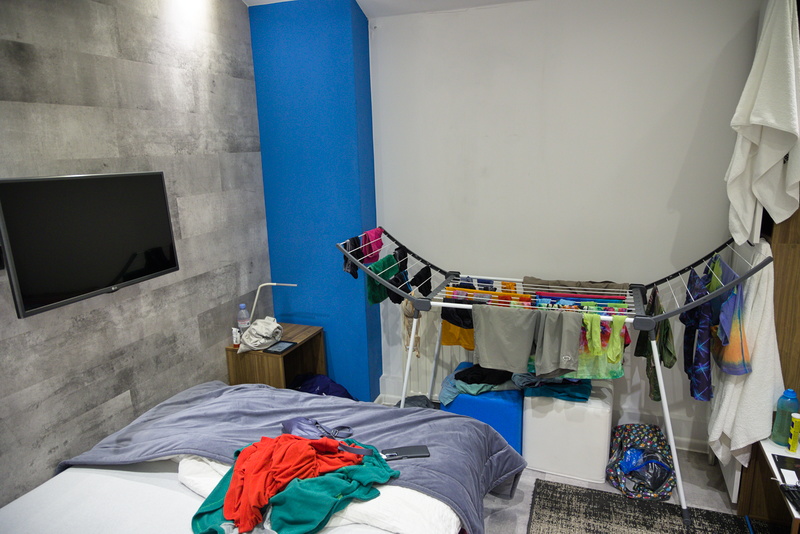
There's a washing machine but no dryer. However, most of our clothes are quick-drying tech fabrics and the room aircon sucks the moisture out. It's not very elegant looking but it does the job.
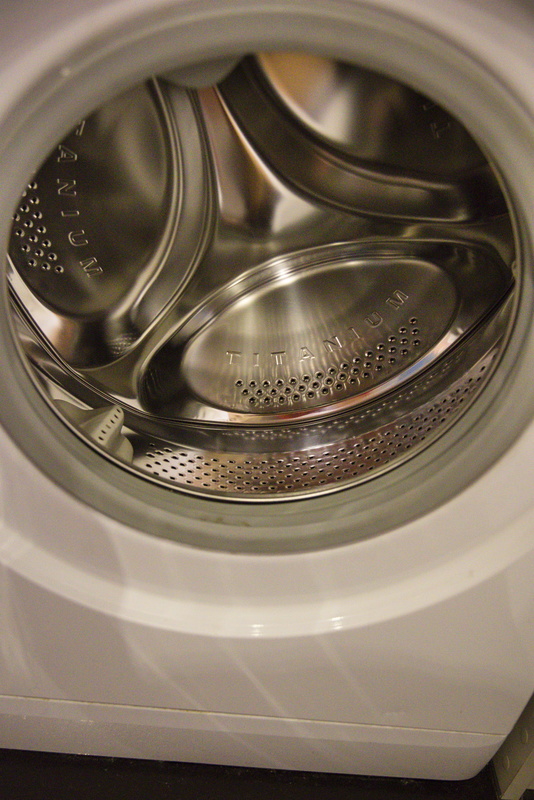
Mind, the washing machine is a surprise. At first glance it looks like a perfectly ordinary machine, but it's barely half the depth of a normal one. The picture doesn't really show just how shallow the drum is. It's sufficient for our limited needs, but we never knew such things existed.
For dinner, we've decided that the splendidy named Moo Moo must be tried. We don't have a reservation, but although they're quite busy they can fit us in.
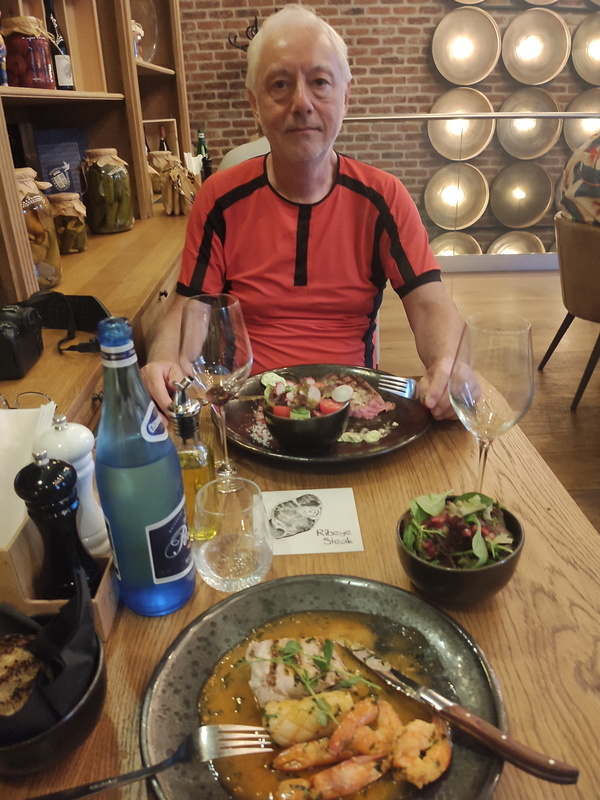
They may not do a wide range of dishes -- if you don't like steak or burger your options are limited -- but what they do, they do very well indeed. I have ribeye steak, Amanda has the "Moo Moo Ocean Set" (including tuna steak, of course) and declares it excellent.
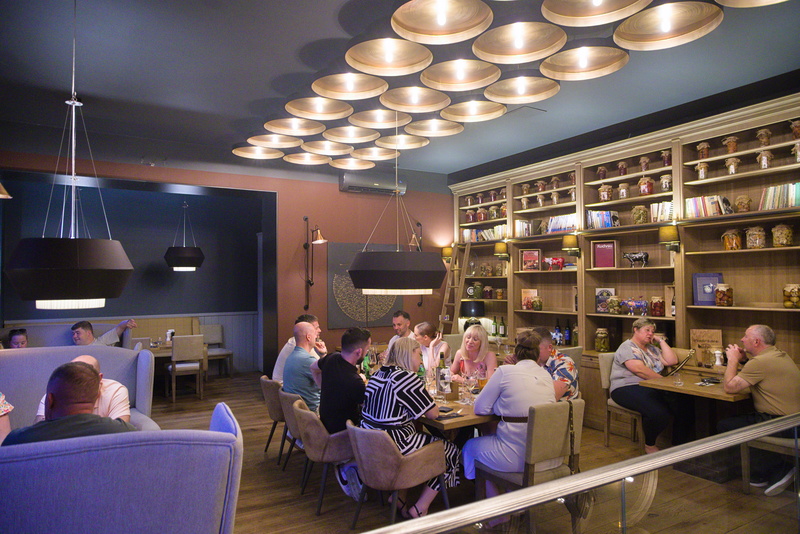
It's a very comfortable and friendly vibe.

And some definitely quirky little touches.
We like it!
Price with starters, wine, etc, comes to just over £93, which is a lot less than we'd pay in London for this quality. Highly recommended.
And so to bed. Tomorrow we begin our cycle tour proper.
⬅ previous ⬆intro next ➡